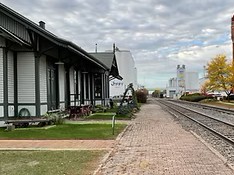Chief Jason Sperle urges Saline City Council to adopt a taxable value-based funding model to ensure long-term stability and improved fire service.
By Doug Marrin
At the February 10, 2025, Saline City Council meeting, Saline Area Fire Department (SAFD) Chief Jason Sperle presented a budget update that underscored the urgent need to transition the department’s funding model.
The proposal, developed in collaboration with the Fire Board and municipal representatives from Saline, Saline Township, Lodi Township, and York Township, seeks to replace the existing percentage-based funding model with a taxable value-based system.
A Push for Predictable Revenue
“Our fiscal goals include modifying our funding model to ensure long-term stability of our department,” Sperle told the council. “Instead of the existing percentage model, we will capture funds based on taxable value. This change will promote overall growth and enhance our ability to plan for the future of the department.”
According to Sperle, the transition to a taxable value-based system is projected to generate 2.98 mills in revenue, allowing SAFD to execute its 10-year strategic plan. The funding would support essential expenditures, including equipment maintenance, personnel protective equipment, and capital improvements such as land acquisition and fire station expansions.
Meeting Staffing and Safety Standards
The department currently struggles to meet key industry safety standards, including MIOSHA’s “two-in, two-out” rule, which requires two firefighters inside and two outside during hazardous operations. Sperle emphasized that the proposed budget would enable SAFD to meet this requirement consistently.
“This budget would allow us to meet MIOSHA standards,” he said. However, he cautioned that staffing levels still lag behind National Fire Protection Association (NFPA) 1710 standards, which require 15 firefighters on the scene within eight minutes. “With mutual aid, we achieve five firefighters on scene at the eight-minute mark and will not achieve 15 members until around 16 minutes if none of the surrounding departments are on a call.”
The new budget plan includes hiring additional firefighters to ensure a minimum of four personnel per shift, preventing staffing gaps due to sick leave or vacation time.
Addressing Long-Term Risks
Sperle’s presentation highlighted that the department’s funding uncertainty has made it difficult to plan for the future. “With the approval of this year’s budget, we will now be positioned to address these risks head-on,” he said. “This budget approval marks the first step in our 10-year strategic plan, enabling us to develop and implement corrective actions tailored to each identified risk.”
The plan includes constructing two additional fire stations, workforce growth, and a revolving fleet replacement schedule. “The renovation of Station 1, the addition of new stations, workforce growth, and the revolving fleet replacement are all essential to enhancing the department’s capabilities in fire suppression, rescue, and prevention, ultimately leading to a safer community.”
He warned that delaying investment would exacerbate existing challenges. “Each delay further exacerbates the challenges faced by the Saline Area Fire Department, increasing the associated risks,” said Sperle. “Maintaining the status quo or failing to invest in our fire department will not enhance services. Rather, it will lead to further deterioration of conditions.”
The Path Forward
Sperle noted that funding concerns are often the sticking point in budget negotiations. However, he urged the council forward, saying, “The community deserves a fully functional fire department today and years down the road,” he said. “That plan starts with the adoption of this year’s budget.”
The city council expects to decide on the budget at its March 3, 2025, meeting.
Photo: Saline Area Fire Department Chief Jason Sperle presents his department’s budget to the city council, February 10, 2025. Image: city video screenshot.






 8123 Main St Suite 200 Dexter, MI 48130
8123 Main St Suite 200 Dexter, MI 48130


